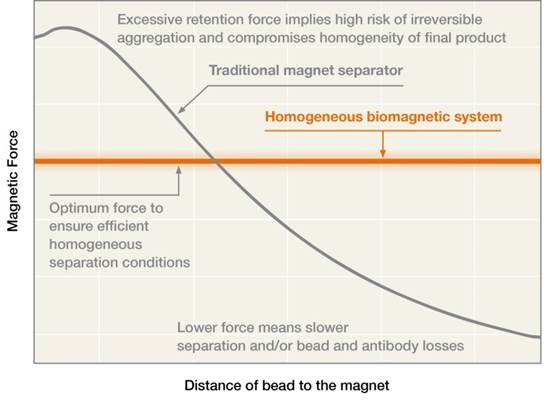Due to the inherent properties of classic non-homogenous biomagnetic separators, beads can aggregate during the magnetic separation process. When this happens, technicians try to resolve the magnetic beads separation problem by using special resuspension techniques like the sonication method. But problems with resuspension can ultimately lead to end-product variability, especially if aggregation is not detected early.
This post is about biomagnetic separation in the production of magnetic beads for IVD kits. If you want to know its most important elements, download our free ebook The basic guide to use biomagnetic separation in production processes:
The problems of bead aggregation
Under homogenous biomagnetic separation conditions, aggregates will move more quickly than individual beads, and therefore the perceived separation time is shorter than expected. If one can continuously monitor the separation process, the technician can be alerted to aggregation problems early in the process.
One of the major problems with aggregated beads is that parts of the surfaces of these compromised beads are not functionalized with the biomolecule of choice (e.g. antibodies, antigen, genetic material, etc.). Optimizing the forces by using homogenous biomagnetic separation will help to minimize aggregation risk. If a lab uses a coating that has a high tendency to aggregate, special resuspension steps such as sonication may be necessary, but usually with gentle separation systems like SEPMAG, rolling the beads is enough to gently disaggregate and resuspend them.
Currently aggregation problems are detected when the biofunctionality of the kits is checked either just before conjugation or at the very end of the process. Detection of aggregation problems at these steps delays the ability of the investigator or technician to take corrective actions in a timely manner or begin a new batch if the aggregation problems are too large.
In addition, the typical steps of biomagnetic separation include several washes after or between biofunctionalization steps. After each of these steps, a magnetic separation process is performed. If the process is monitored and biomagnetic separation is homogenous, aggregated beads will move more quickly than non-aggregated beads. Theoretically and in practice, aggregated beads essentially act as larger magnetic beads (larger bead diameter = larger magnetic moment). When this happens, the time it takes to separate the beads will be shorter than calculated by the standard curve. In addition, if the concentration of the beads is not changed from wash to wash, the separation time will be shorter in each successive biomagnetic separation step because the aggregation is cumulative.
Advantages of reducing bead aggregation
It is important to note that the risk of aggregation will never be zero. But early detection would allow technicians to take immediate corrective action before performing the expensive coating or conjugation steps with costly biomolecules. Sometimes this corrective action can be as simple as repeating the resuspension process. Monitoring would save time and needless added cost of discarding large batches that fail QC due to in-lot inconsistencies, the normal consequence of detecting aggregation problems too late. SEPMAG technology provides monitoring in real time which circumvents added costs and other problems due to bead aggregation in non-homogenous systems.
If you found this post about using biomagnetic separation for production useful, don't forget to check these related posts:
- Perfecting the magnetic separation process in magnetic bead IVD kit production
- Determining the Right Separation Time during Biomagnetic Separation Processes
- Avoiding Irreversible Aggregation Problems during Production
Check www.sepmag.eu/ebooks to access to FREE eBooks on the subject, or contact us. We will be glad to help you to achieve an efficient magnetic bead separation process!





